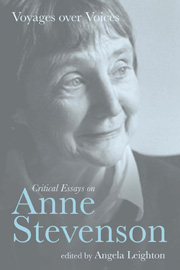Book contents
- Frontmatter
- Contents
- Notes on Contributors
- Acknowledgements
- ‘Making Poetry’
- 1 ‘Voyages over voices’: Introduction
- 2 The Melting Metaphor
- 3 ‘Between us’: Letters and Poems of Stevenson and Bishop
- 4 Mothers, Mirrors, Doubles: Anne Stevenson's Elegies for Sylvia Plath
- 5 Staging Second Thoughts: The Poetry of Anne Stevenson
- 6 ‘Making Poetry’: The Exemplary Anne Stevenson
- 7 ‘A curved adventure’: Romanticism and the Poetry of Anne Stevenson
- 8 The Nature of Anne Stevenson
- 9 Anne Stevenson and the Poetry of Place
- 10 Compacting Time: Anne Stevenson's Poems of Memory
- 11 ‘Not exactly a persona’: Pronouns in Anne Stevenson's Poetry
- 12 ‘To serve a girl on terrible terms’: Anne Stevenson's Writing Selves
- 13 Talking and Singing: Anne Stevenson's Variations on a Rhythmical Theme
- 14 ‘Time will erase’: Anne Stevenson and Elegy
- 15 Observing the Overhearing: The Anne Stevenson Papers in Cambridge University Library
- 16 Bibliography of Anne Stevenson's Published Works
- General Index
- Index of Stevenson's Works
3 - ‘Between us’: Letters and Poems of Stevenson and Bishop
- Frontmatter
- Contents
- Notes on Contributors
- Acknowledgements
- ‘Making Poetry’
- 1 ‘Voyages over voices’: Introduction
- 2 The Melting Metaphor
- 3 ‘Between us’: Letters and Poems of Stevenson and Bishop
- 4 Mothers, Mirrors, Doubles: Anne Stevenson's Elegies for Sylvia Plath
- 5 Staging Second Thoughts: The Poetry of Anne Stevenson
- 6 ‘Making Poetry’: The Exemplary Anne Stevenson
- 7 ‘A curved adventure’: Romanticism and the Poetry of Anne Stevenson
- 8 The Nature of Anne Stevenson
- 9 Anne Stevenson and the Poetry of Place
- 10 Compacting Time: Anne Stevenson's Poems of Memory
- 11 ‘Not exactly a persona’: Pronouns in Anne Stevenson's Poetry
- 12 ‘To serve a girl on terrible terms’: Anne Stevenson's Writing Selves
- 13 Talking and Singing: Anne Stevenson's Variations on a Rhythmical Theme
- 14 ‘Time will erase’: Anne Stevenson and Elegy
- 15 Observing the Overhearing: The Anne Stevenson Papers in Cambridge University Library
- 16 Bibliography of Anne Stevenson's Published Works
- General Index
- Index of Stevenson's Works
Summary
In 1961 Anne Stevenson attended Donald Hall's poetry workshop, where she was first introduced to the poetry of Wallace Stevens, Elizabeth Bishop and Robert Lowell. Bishop and Stevens particularly impressed her with ‘the originality of their intelligence’. At the time, Bishop's poetry was not studied very seriously. She was chiefly admired, as Stevenson pointed out in a 1995 lecture, ‘for the finely observed details she “painted” into her poems’. Stevenson resisted this clichéd view of Bishop's poetry from the outset. She saw her not as a miniaturist of everyday life but as a sophisticated poet of ideas. In 1962 Twayne Publishers commissioned her to write the first critical study of Bishop's writing. Stevenson had published some individual poems herself, but was still three years short of completing her first collection, Living in America, published in 1965. Bishop had already published two collections of poetry by this point, the second of which had been awarded the Pulitzer Prize in 1956. Yet for all their differences in accomplishment, the two poets had much in common, not least a love of music and visual art that quickly became apparent once they began corresponding in 1963.
Stevenson was twenty-nine years old in the year she began writing the Twayne book; Bishop was fifty-one. Her main problem upon commencing the book was how to place Bishop's writing: ‘I hadn't then realized that one needn't always place poets; and such a thing as a woman's tradition never then occurred to me’. Before placing the poetry, however, Stevenson had literally to locate where Bishop lived, no easy task given the fact that she resided in Brazil at the time. Stevenson was nervous about contacting Bishop by letter and wrote to the poet Marianne Moore, first, expressing her fear that Bishop despised ‘professionalized criticism’.
- Type
- Chapter
- Information
- Voyages over VoicesCritical Essays on Anne Stevenson, pp. 28 - 54Publisher: Liverpool University PressPrint publication year: 2010

